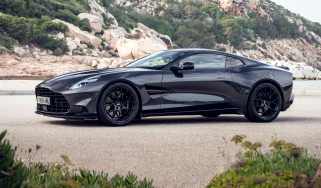Morgan Lifecar
Forward-looking Morgan could be inproduction in just two years but the technology inside has changed
Morgan revealed its LifeCar concept a year ago, at the Geneva motor show. This ultra-lightweight, skinny-tyred, fuel-cell-powered piece of retro-modern fusion showcased a future direction for the company, promising a proper sports-car drive while emitting nothing but water.
A year on, Morgan is celebrating its 100th anniversary – but it will not be showing a latest-spec LifeCar at the 2009 Geneva Salon. The project hasn’t died, however. In fact it has become a lot more serious. ‘We don’t want to draw too much attention to the LifeCar at the moment,’ chairman Charles Morgan told evo, ‘because we’re working on prototypes and there’s nothing visual to show yet.’
But what Morgan did reveal is that the LifeCar is intended as a proper production machine, pencilled in for completion, and maybe even launch, in a couple of years’ time. There still won’t be a readily accessible hydrogen supply infrastructure by then, though, so the LifeCar has undergone a fundamental engineering shift. In place of the fuel cell will be a small internal combustion engine. Whether it will be petrol- or diesel-fuelled has yet to be finalised by the research teams at Cranfield, Birmingham and Oxford universities, but whichever it is, it will be responsible solely for powering the generator that supplies the car’s four electric motors and keeps the ultracapacitors charged.
Sound familiar? It’s similar to the system employed by the current toast of automotive-future talk, the Chevrolet Volt plug-in hybrid. However, the key difference is that the Volt’s energy reservoirs are its batteries, which can be recharged overnight from the mains or on the go from the engine. The LifeCar lacks batteries but instead has ultracapacitors that can be charged much more quickly and give a bigger spike of output when needed. The downside is that ultracapacitors can’t hold as much charge so the LifeCar can run little distance on them alone. Nor is there much point in plugging the car into the mains. So the LifeCar gets its efficiency from the optimal use of its engine. By running it at a near-constant speed it can be tuned to get the most from its fuel instead of having to cope with a variety of speeds and loads. Regenerative braking also helps replenish the ultracapacitor.
Having a separate motor for each wheel – chassis-mounted and connected by driveshafts to minimise unsprung weight – allows interesting dynamic possibilities. ‘The idea is to write the software so it’s a real sports car,’ says Morgan. ‘It will have four-wheel drive and we can speed up the wheels on the outside of a curve.’So in two years’ time we’ll be driving a whole new kind of Morgan, albeit one loosely based on the Aero’s bonded-aluminium platform. A fuel-cell version will likely still follow if hydrogen becomes more available, but meanwhile we’d better get used to a new world of six-phase motors, bridge circuits, axial flux and bus voltages.





